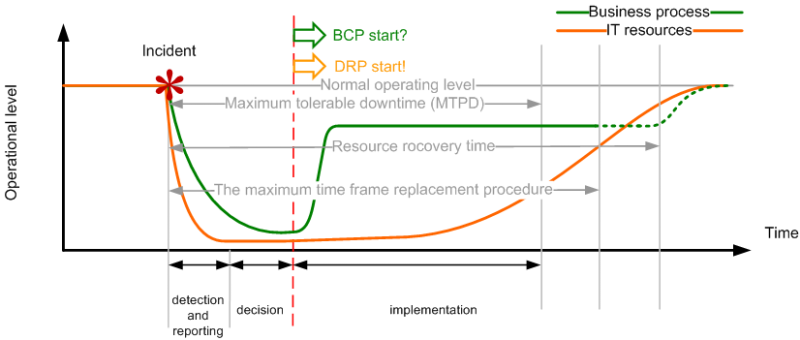Business continuity planning (BCP – DRP)
The operation of the company, and maintaining its prosperity greatly depend on the availability of business process supporting IT infrastructure. Of course, everyone strives for providing the operation of these systems, but we have to prepare for events when – as an effect of internal or external conditions – the regular workflow can not be maintained.
These kind of catastrophic events have to start two processes. On the one hand the restoration of dropped resources (DRP), and on the other hand the minimal functionality providing business operation excluding the dropped resources.
The relation between the BCP and DRP:

The DRP always starts when any of the business process supporting resource drops out. The BCP however starts only, when the restoration time of the resource exceeds the maximally tolerable dropping time. If it is shorter, there is no need to activate BCP, because the department tolerates the drop out. Regardless its activation, the two have to work closely together. Because of this, it is suggested not to build them up separately, however the BCP and the DRP managements are usually separated at the level of organization.
The base of the BCP and the DRP are the well accomplished Business impact analysis (BIA) and Risk analysis. These are providing the list of relevant resources and threats, and the maximally tolerable dropping out time as well.
Phases of implementation:
- Preparation
- Business impact analysis (BIA)
- Risk analysis
- Selecting of relevant business processes
- Selecting of relevant resources
- Business continuity planning
- Development of business continuity strategy
- Development of regulatory framework
- Preparation of activation handbooks (BCP – DRP)
- Preparation of action plans (BCP – DRP)
- Testing
- Common test of action plans
- Application of test experiences
Products of these processes:
- Business process data sheets
- IT system overview
- IT service catalog
- List of relevant supporting resources
- Data assets inventory
- Risk analysis report
- Risk management suggestions
- Business impact analysis
- Business continuity strategy
- Business continuity framework
- Activation handbooks
- Action plans


